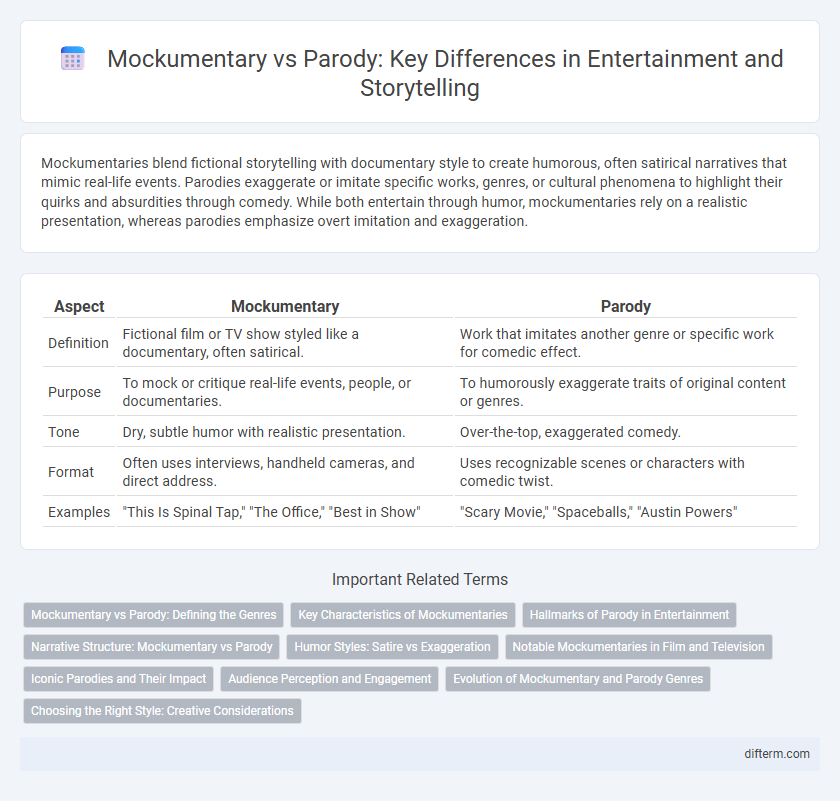Mockumentaries blend fictional storytelling with documentary style to create humorous, often satirical narratives that mimic real-life events. Parodies exaggerate or imitate specific works, genres, or cultural phenomena to highlight their quirks and absurdities through comedy. While both entertain through humor, mockumentaries rely on a realistic presentation, whereas parodies emphasize overt imitation and exaggeration.
Table of Comparison
| Aspect | Mockumentary | Parody |
|---|---|---|
| Definition | Fictional film or TV show styled like a documentary, often satirical. | Work that imitates another genre or specific work for comedic effect. |
| Purpose | To mock or critique real-life events, people, or documentaries. | To humorously exaggerate traits of original content or genres. |
| Tone | Dry, subtle humor with realistic presentation. | Over-the-top, exaggerated comedy. |
| Format | Often uses interviews, handheld cameras, and direct address. | Uses recognizable scenes or characters with comedic twist. |
| Examples | "This Is Spinal Tap," "The Office," "Best in Show" | "Scary Movie," "Spaceballs," "Austin Powers" |
Mockumentary vs Parody: Defining the Genres
Mockumentaries blend fictional narratives with documentary-style filmmaking to create a satirical or humorous effect, often mimicking real-life scenarios to offer social commentary. Parodies exaggerate and imitate specific works, genres, or styles to generate humor by highlighting their most recognizable traits. Understanding the distinction lies in mockumentaries presenting invented reality through documentary techniques, while parodies rely on direct spoofing of existing media.
Key Characteristics of Mockumentaries
Mockumentaries blend fictional storytelling with documentary-style filmmaking, characterized by realistic interviews, handheld camera work, and improvised dialogue that mimic true documentary techniques. They often use satire to critique real-life events or cultural phenomena, creating a nuanced form of humor that is both engaging and thought-provoking. Key characteristics include a faux-serious tone, deadpan delivery, and blending fact with fiction to blur the lines between reality and comedy.
Hallmarks of Parody in Entertainment
Parody in entertainment is characterized by its humorous imitation of a specific genre, work, or artist, exaggerating distinctive features for comedic effect. Key hallmarks include recognizable references, satire targeting the original subject's style or themes, and an intent to entertain through witty critique rather than deceptive realism. Unlike mockumentaries, which mimic the documentary format to create a faux-realistic narrative, parodies prioritize overt exaggeration and playful mockery.
Narrative Structure: Mockumentary vs Parody
Mockumentaries utilize a narrative structure that mimics real documentary filmmaking, featuring interviews, spontaneous dialogue, and on-location shooting to create a believable yet satirical story world. Parodies rely on exaggerated imitation of specific genres, styles, or works, emphasizing humor through hyperbole and direct references rather than maintaining a cohesive documentary-style narrative. The mockumentary format often blurs the line between fact and fiction, while parodies prioritize entertainment through overt comedic exaggeration.
Humor Styles: Satire vs Exaggeration
Mockumentaries employ satire to humorously critique real-life events or societal norms by mimicking documentary styles with sharp, often ironic insights. Parodies rely on exaggerated imitation, amplifying recognizable traits of a genre, character, or work to create humor through absurdity and over-the-top scenarios. The key difference lies in mockumentaries' subtle, incisive social commentary versus parodies' overt, playful distortion for comedic effect.
Notable Mockumentaries in Film and Television
Notable mockumentaries like "This Is Spinal Tap," "The Office," and "Parks and Recreation" use a documentary-style approach to create humor through fictional narratives presented as real-life events. Unlike parodies that primarily mimic and exaggerate specific genres or works, mockumentaries blend satire and realism to explore characters and social commentary. These productions emphasize improvisational acting and deadpan delivery, making them distinct in film and television entertainment.
Iconic Parodies and Their Impact
Iconic parodies like *Scary Movie* and *Spaceballs* cleverly mimic popular genres, highlighting cultural trends through exaggerated humor that resonates widely with audiences. Mockumentaries such as *This Is Spinal Tap* and *The Office* blend fictional storytelling with documentary style to create immersive, satirical experiences that critique societal norms and entertainment industry tropes. Both formats significantly influence pop culture by shaping audience perceptions and contributing to the ongoing dialogue about media and entertainment conventions.
Audience Perception and Engagement
Mockumentaries engage audiences by blending fictional storytelling with documentary-style presentation, fostering a sense of authenticity that invites viewers to critically analyze social issues or industry practices. Parodies rely on exaggeration and imitation of recognizable genres or works, evoking humor through satire and prompting audiences to recognize and appreciate cultural references. Audience perception varies as mockumentaries often encourage reflective engagement, while parodies primarily stimulate entertainment through comedic familiarity.
Evolution of Mockumentary and Parody Genres
The evolution of the mockumentary genre traces back to early works like "This Is Spinal Tap" and "The Office," where the blend of fictional storytelling and documentary-style filmmaking created a unique comedic experience. Parody, with roots in classical satire, evolved through exaggerated imitations found in films like "Scary Movie" and "Austin Powers," emphasizing humor through direct spoofing of genre conventions. Both mockumentary and parody have expanded in entertainment, leveraging self-referential humor and cultural commentary to engage contemporary audiences effectively.
Choosing the Right Style: Creative Considerations
Mockumentaries use a documentary style to create humor through fictional storytelling presented as factual, emphasizing irony and satire. Parodies mimic the style or content of a specific genre, work, or artist to evoke laughter by exaggeration and imitation. When choosing the right style, consider the audience's familiarity with the source material, the desired depth of satire, and the narrative's reliance on realism versus overt comedy.
mockumentary vs parody Infographic

 difterm.com
difterm.com